Southern Cross University: ACC00716 Finance Risk and Return Analysis
VerifiedAdded on 2023/01/19
|12
|2329
|74
Report
AI Summary
This finance report analyzes the securities of CSL Ltd, a biotechnology company, focusing on risk and return relationships. It applies the Capital Asset Pricing Model (CAPM) to demonstrate these relationships and uses graphical representations. The report covers systematic and unsystematic risks, portfolio management strategies, and the Security Market Line (SML) to evaluate investment options. The assessment includes calculations and analysis of CAPM components, risk factors, and diversification strategies, concluding with an evaluation of portfolio returns and beta. The report provides a comprehensive overview of investment decision-making processes, highlighting the importance of risk assessment and portfolio diversification in finance.

Running head: FINANCE
Finance
Name of the Student:
Name of the University:
Authors Note:
Finance
Name of the Student:
Name of the University:
Authors Note:
Paraphrase This Document
Need a fresh take? Get an instant paraphrase of this document with our AI Paraphraser
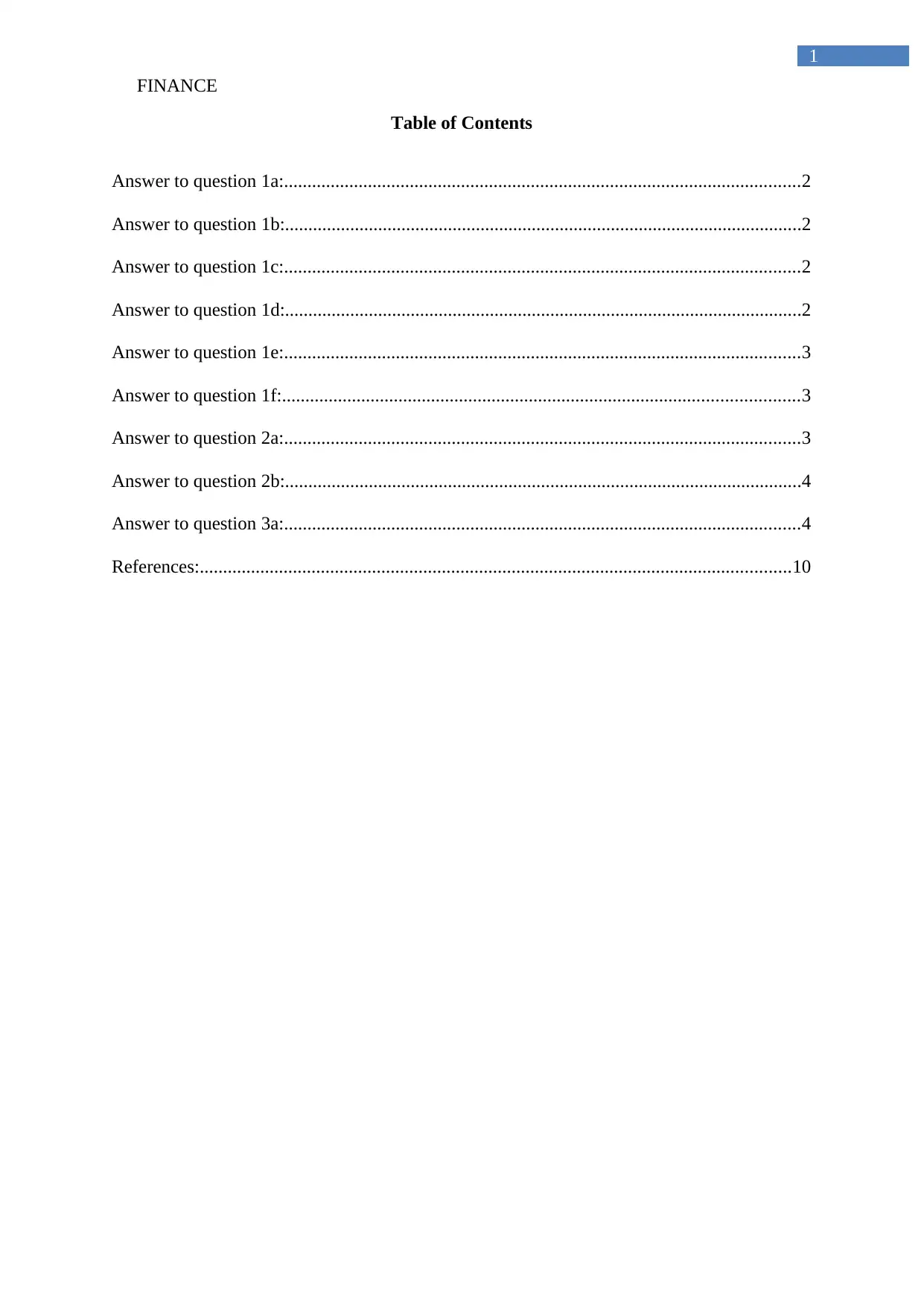
FINANCE
1
Table of Contents
Answer to question 1a:...............................................................................................................2
Answer to question 1b:...............................................................................................................2
Answer to question 1c:...............................................................................................................2
Answer to question 1d:...............................................................................................................2
Answer to question 1e:...............................................................................................................3
Answer to question 1f:...............................................................................................................3
Answer to question 2a:...............................................................................................................3
Answer to question 2b:...............................................................................................................4
Answer to question 3a:...............................................................................................................4
References:...............................................................................................................................10
1
Table of Contents
Answer to question 1a:...............................................................................................................2
Answer to question 1b:...............................................................................................................2
Answer to question 1c:...............................................................................................................2
Answer to question 1d:...............................................................................................................2
Answer to question 1e:...............................................................................................................3
Answer to question 1f:...............................................................................................................3
Answer to question 2a:...............................................................................................................3
Answer to question 2b:...............................................................................................................4
Answer to question 3a:...............................................................................................................4
References:...............................................................................................................................10
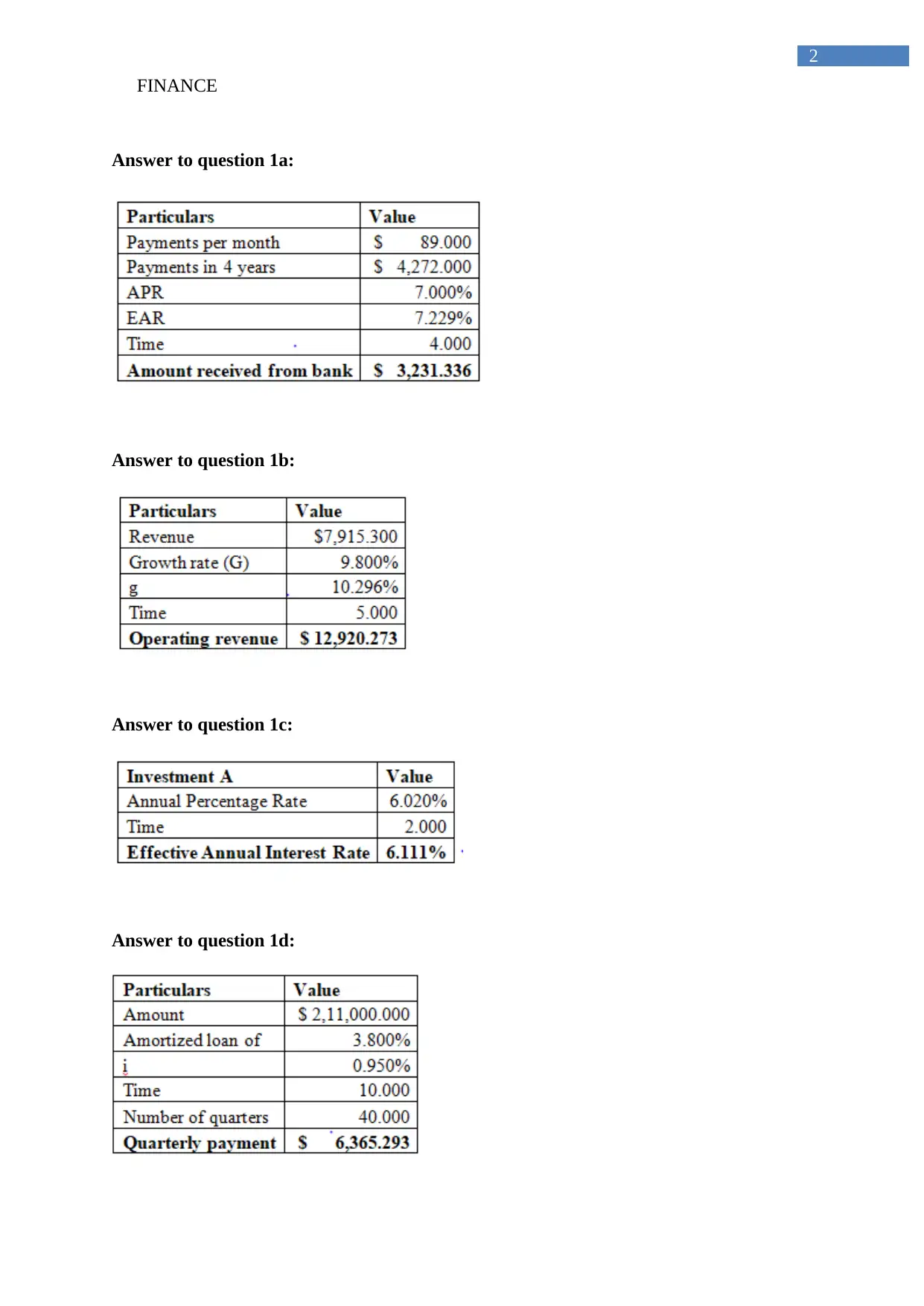
FINANCE
2
Answer to question 1a:
Answer to question 1b:
Answer to question 1c:
Answer to question 1d:
2
Answer to question 1a:
Answer to question 1b:
Answer to question 1c:
Answer to question 1d:
⊘ This is a preview!⊘
Do you want full access?
Subscribe today to unlock all pages.

Trusted by 1+ million students worldwide
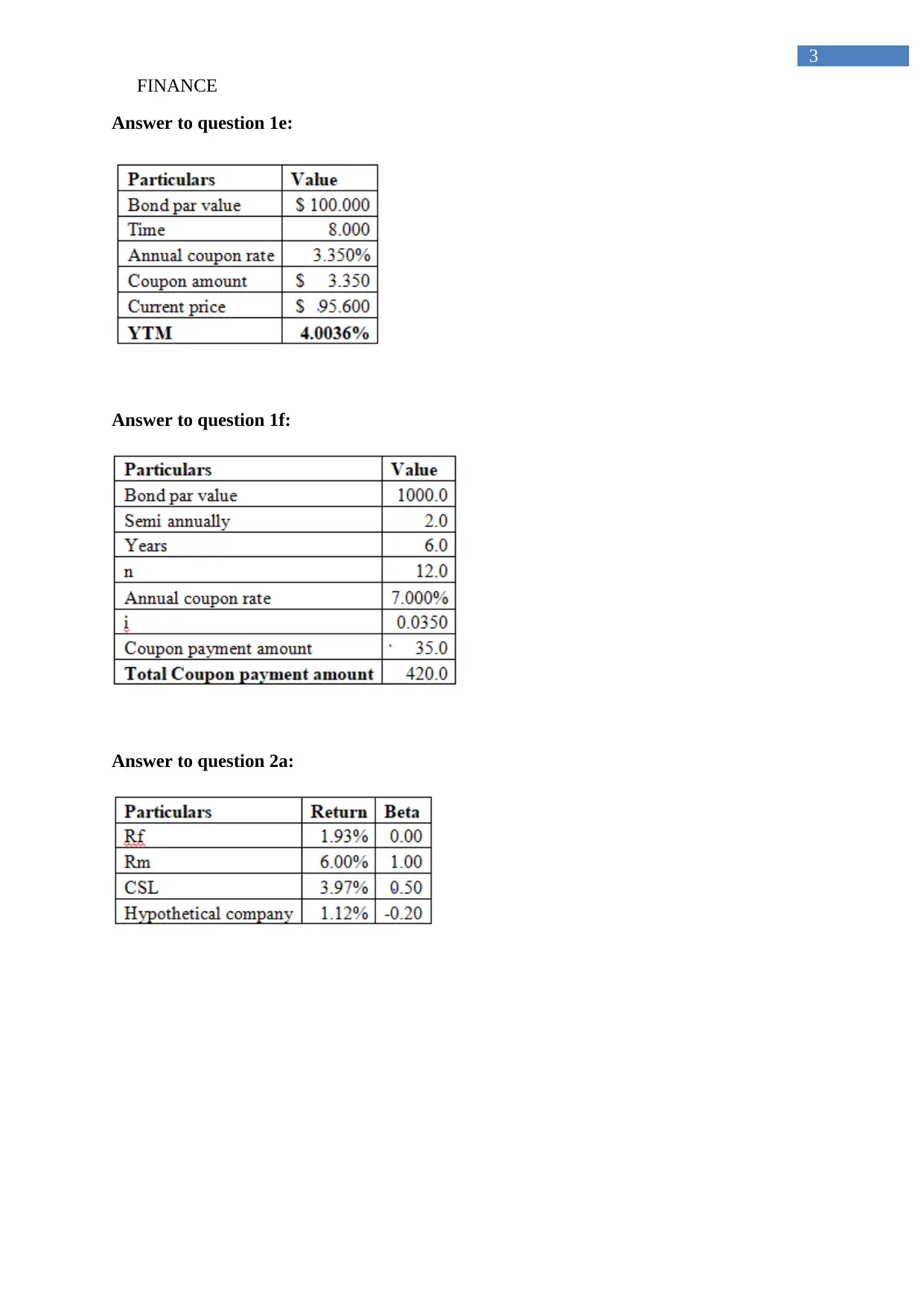
FINANCE
3
Answer to question 1e:
Answer to question 1f:
Answer to question 2a:
3
Answer to question 1e:
Answer to question 1f:
Answer to question 2a:
Paraphrase This Document
Need a fresh take? Get an instant paraphrase of this document with our AI Paraphraser
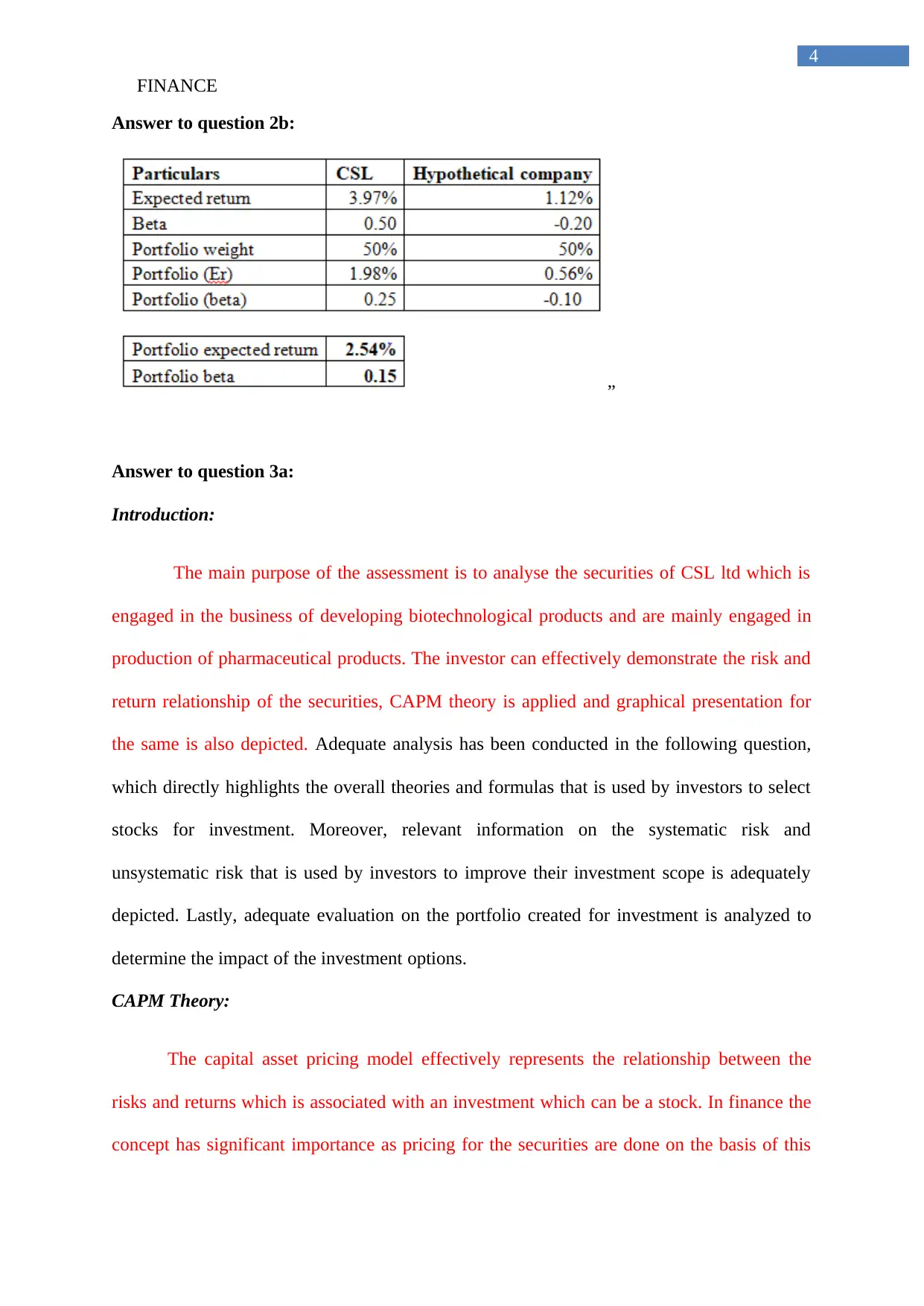
FINANCE
4
Answer to question 2b:
”
Answer to question 3a:
Introduction:
The main purpose of the assessment is to analyse the securities of CSL ltd which is
engaged in the business of developing biotechnological products and are mainly engaged in
production of pharmaceutical products. The investor can effectively demonstrate the risk and
return relationship of the securities, CAPM theory is applied and graphical presentation for
the same is also depicted. Adequate analysis has been conducted in the following question,
which directly highlights the overall theories and formulas that is used by investors to select
stocks for investment. Moreover, relevant information on the systematic risk and
unsystematic risk that is used by investors to improve their investment scope is adequately
depicted. Lastly, adequate evaluation on the portfolio created for investment is analyzed to
determine the impact of the investment options.
CAPM Theory:
The capital asset pricing model effectively represents the relationship between the
risks and returns which is associated with an investment which can be a stock. In finance the
concept has significant importance as pricing for the securities are done on the basis of this
4
Answer to question 2b:
”
Answer to question 3a:
Introduction:
The main purpose of the assessment is to analyse the securities of CSL ltd which is
engaged in the business of developing biotechnological products and are mainly engaged in
production of pharmaceutical products. The investor can effectively demonstrate the risk and
return relationship of the securities, CAPM theory is applied and graphical presentation for
the same is also depicted. Adequate analysis has been conducted in the following question,
which directly highlights the overall theories and formulas that is used by investors to select
stocks for investment. Moreover, relevant information on the systematic risk and
unsystematic risk that is used by investors to improve their investment scope is adequately
depicted. Lastly, adequate evaluation on the portfolio created for investment is analyzed to
determine the impact of the investment options.
CAPM Theory:
The capital asset pricing model effectively represents the relationship between the
risks and returns which is associated with an investment which can be a stock. In finance the
concept has significant importance as pricing for the securities are done on the basis of this
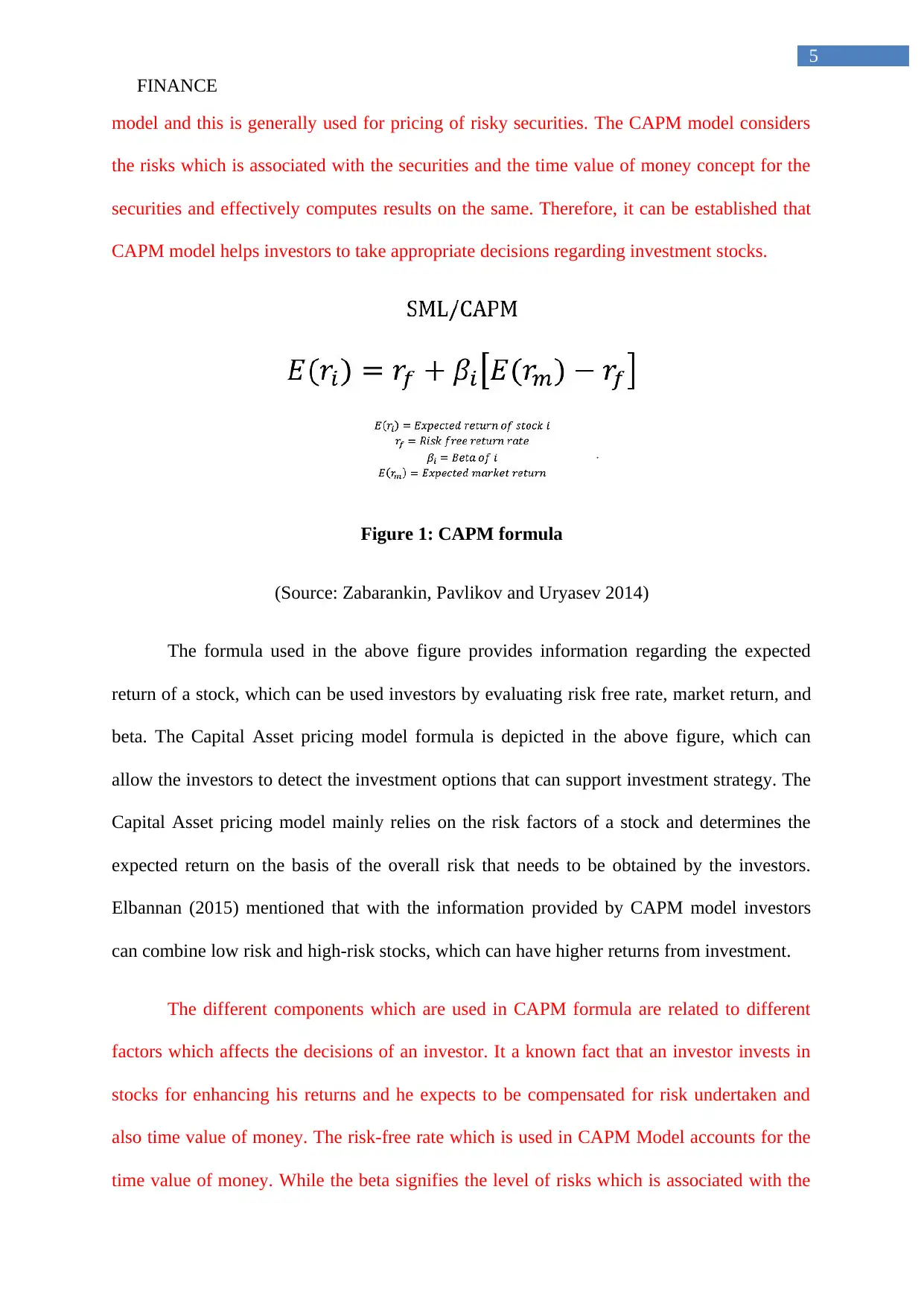
FINANCE
5
model and this is generally used for pricing of risky securities. The CAPM model considers
the risks which is associated with the securities and the time value of money concept for the
securities and effectively computes results on the same. Therefore, it can be established that
CAPM model helps investors to take appropriate decisions regarding investment stocks.
Figure 1: CAPM formula
(Source: Zabarankin, Pavlikov and Uryasev 2014)
The formula used in the above figure provides information regarding the expected
return of a stock, which can be used investors by evaluating risk free rate, market return, and
beta. The Capital Asset pricing model formula is depicted in the above figure, which can
allow the investors to detect the investment options that can support investment strategy. The
Capital Asset pricing model mainly relies on the risk factors of a stock and determines the
expected return on the basis of the overall risk that needs to be obtained by the investors.
Elbannan (2015) mentioned that with the information provided by CAPM model investors
can combine low risk and high-risk stocks, which can have higher returns from investment.
The different components which are used in CAPM formula are related to different
factors which affects the decisions of an investor. It a known fact that an investor invests in
stocks for enhancing his returns and he expects to be compensated for risk undertaken and
also time value of money. The risk-free rate which is used in CAPM Model accounts for the
time value of money. While the beta signifies the level of risks which is associated with the
5
model and this is generally used for pricing of risky securities. The CAPM model considers
the risks which is associated with the securities and the time value of money concept for the
securities and effectively computes results on the same. Therefore, it can be established that
CAPM model helps investors to take appropriate decisions regarding investment stocks.
Figure 1: CAPM formula
(Source: Zabarankin, Pavlikov and Uryasev 2014)
The formula used in the above figure provides information regarding the expected
return of a stock, which can be used investors by evaluating risk free rate, market return, and
beta. The Capital Asset pricing model formula is depicted in the above figure, which can
allow the investors to detect the investment options that can support investment strategy. The
Capital Asset pricing model mainly relies on the risk factors of a stock and determines the
expected return on the basis of the overall risk that needs to be obtained by the investors.
Elbannan (2015) mentioned that with the information provided by CAPM model investors
can combine low risk and high-risk stocks, which can have higher returns from investment.
The different components which are used in CAPM formula are related to different
factors which affects the decisions of an investor. It a known fact that an investor invests in
stocks for enhancing his returns and he expects to be compensated for risk undertaken and
also time value of money. The risk-free rate which is used in CAPM Model accounts for the
time value of money. While the beta signifies the level of risks which is associated with the
⊘ This is a preview!⊘
Do you want full access?
Subscribe today to unlock all pages.

Trusted by 1+ million students worldwide
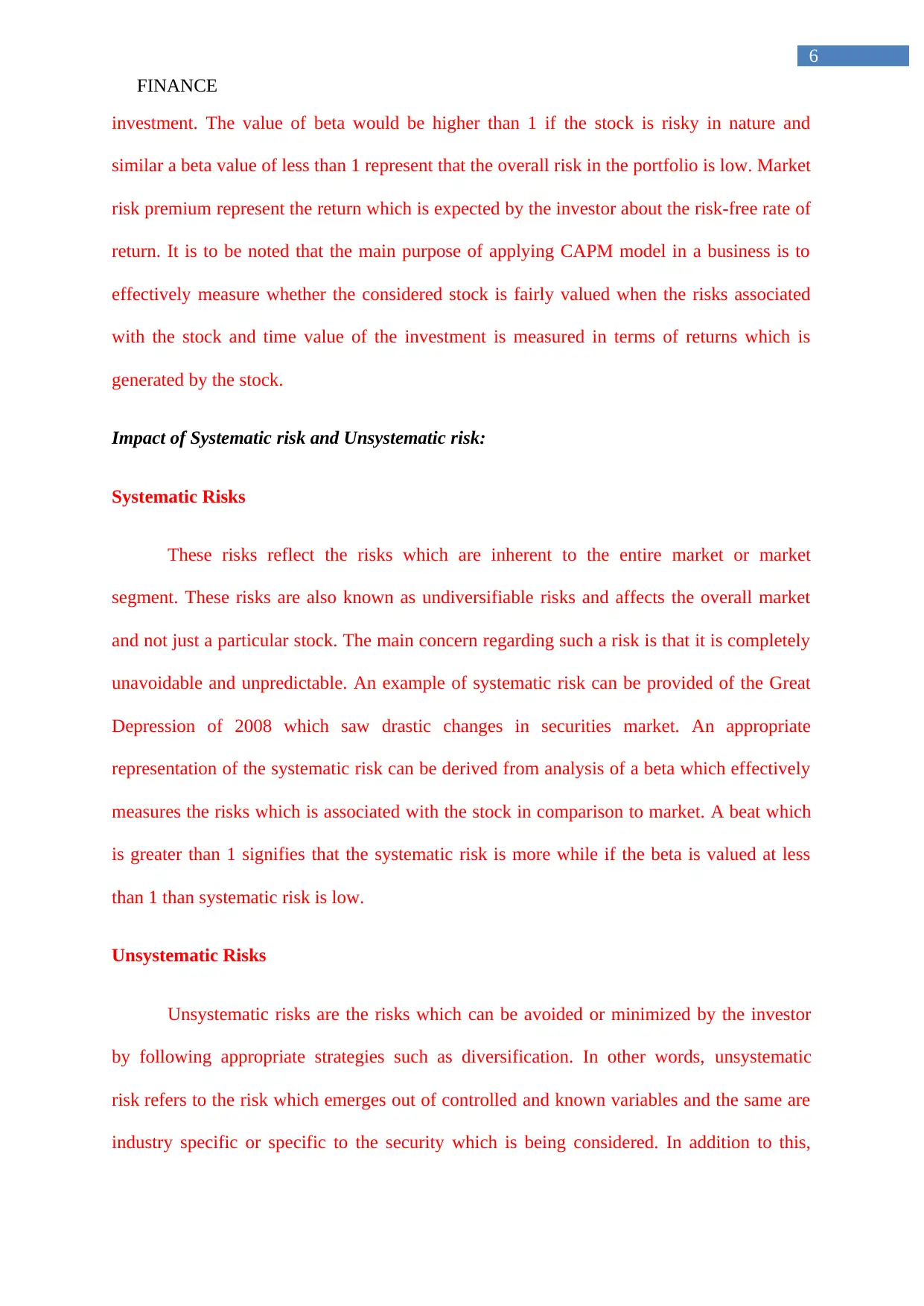
FINANCE
6
investment. The value of beta would be higher than 1 if the stock is risky in nature and
similar a beta value of less than 1 represent that the overall risk in the portfolio is low. Market
risk premium represent the return which is expected by the investor about the risk-free rate of
return. It is to be noted that the main purpose of applying CAPM model in a business is to
effectively measure whether the considered stock is fairly valued when the risks associated
with the stock and time value of the investment is measured in terms of returns which is
generated by the stock.
Impact of Systematic risk and Unsystematic risk:
Systematic Risks
These risks reflect the risks which are inherent to the entire market or market
segment. These risks are also known as undiversifiable risks and affects the overall market
and not just a particular stock. The main concern regarding such a risk is that it is completely
unavoidable and unpredictable. An example of systematic risk can be provided of the Great
Depression of 2008 which saw drastic changes in securities market. An appropriate
representation of the systematic risk can be derived from analysis of a beta which effectively
measures the risks which is associated with the stock in comparison to market. A beat which
is greater than 1 signifies that the systematic risk is more while if the beta is valued at less
than 1 than systematic risk is low.
Unsystematic Risks
Unsystematic risks are the risks which can be avoided or minimized by the investor
by following appropriate strategies such as diversification. In other words, unsystematic
risk refers to the risk which emerges out of controlled and known variables and the same are
industry specific or specific to the security which is being considered. In addition to this,
6
investment. The value of beta would be higher than 1 if the stock is risky in nature and
similar a beta value of less than 1 represent that the overall risk in the portfolio is low. Market
risk premium represent the return which is expected by the investor about the risk-free rate of
return. It is to be noted that the main purpose of applying CAPM model in a business is to
effectively measure whether the considered stock is fairly valued when the risks associated
with the stock and time value of the investment is measured in terms of returns which is
generated by the stock.
Impact of Systematic risk and Unsystematic risk:
Systematic Risks
These risks reflect the risks which are inherent to the entire market or market
segment. These risks are also known as undiversifiable risks and affects the overall market
and not just a particular stock. The main concern regarding such a risk is that it is completely
unavoidable and unpredictable. An example of systematic risk can be provided of the Great
Depression of 2008 which saw drastic changes in securities market. An appropriate
representation of the systematic risk can be derived from analysis of a beta which effectively
measures the risks which is associated with the stock in comparison to market. A beat which
is greater than 1 signifies that the systematic risk is more while if the beta is valued at less
than 1 than systematic risk is low.
Unsystematic Risks
Unsystematic risks are the risks which can be avoided or minimized by the investor
by following appropriate strategies such as diversification. In other words, unsystematic
risk refers to the risk which emerges out of controlled and known variables and the same are
industry specific or specific to the security which is being considered. In addition to this,
Paraphrase This Document
Need a fresh take? Get an instant paraphrase of this document with our AI Paraphraser
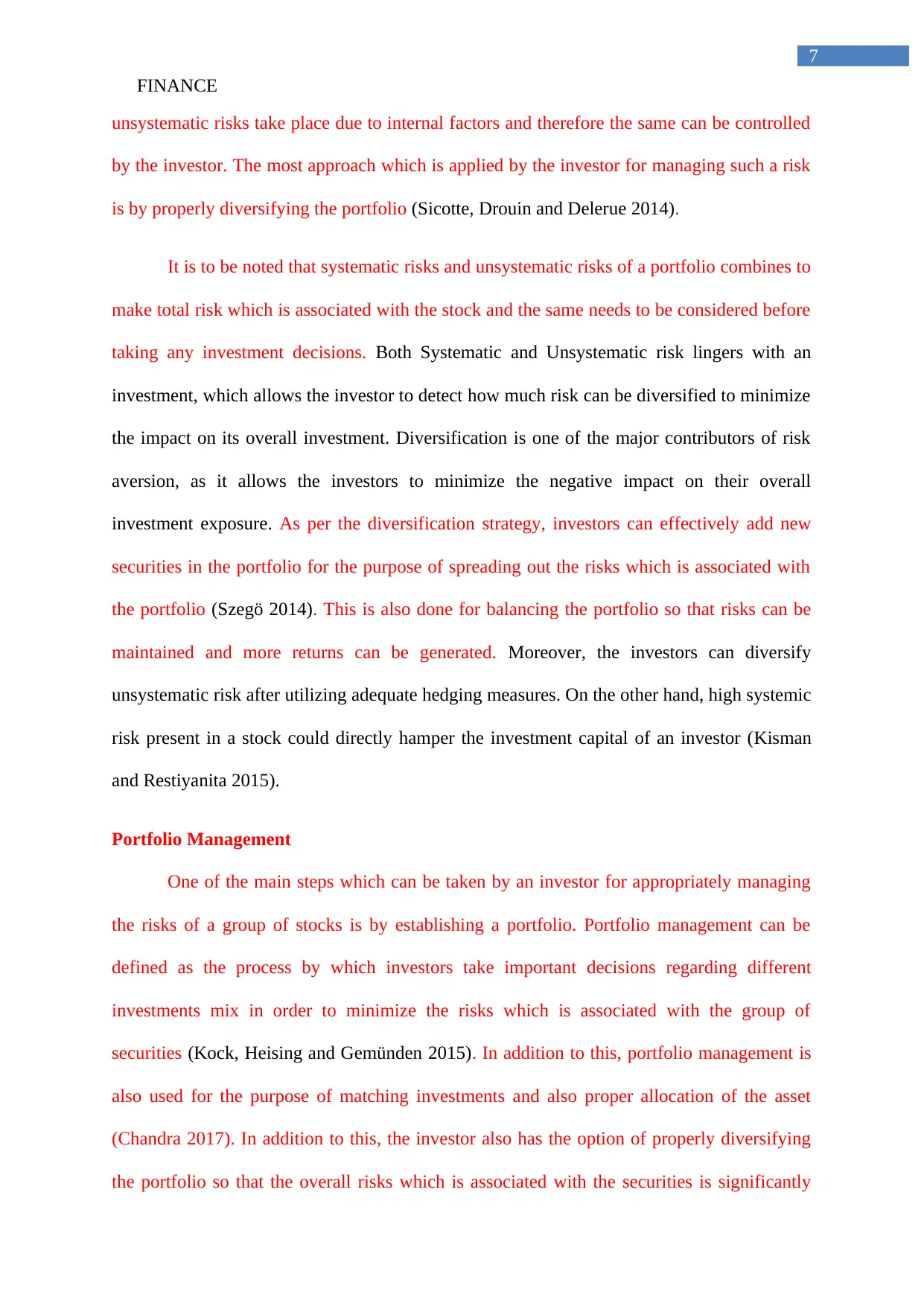
FINANCE
7
unsystematic risks take place due to internal factors and therefore the same can be controlled
by the investor. The most approach which is applied by the investor for managing such a risk
is by properly diversifying the portfolio (Sicotte, Drouin and Delerue 2014).
It is to be noted that systematic risks and unsystematic risks of a portfolio combines to
make total risk which is associated with the stock and the same needs to be considered before
taking any investment decisions. Both Systematic and Unsystematic risk lingers with an
investment, which allows the investor to detect how much risk can be diversified to minimize
the impact on its overall investment. Diversification is one of the major contributors of risk
aversion, as it allows the investors to minimize the negative impact on their overall
investment exposure. As per the diversification strategy, investors can effectively add new
securities in the portfolio for the purpose of spreading out the risks which is associated with
the portfolio (Szegö 2014). This is also done for balancing the portfolio so that risks can be
maintained and more returns can be generated. Moreover, the investors can diversify
unsystematic risk after utilizing adequate hedging measures. On the other hand, high systemic
risk present in a stock could directly hamper the investment capital of an investor (Kisman
and Restiyanita 2015).
Portfolio Management
One of the main steps which can be taken by an investor for appropriately managing
the risks of a group of stocks is by establishing a portfolio. Portfolio management can be
defined as the process by which investors take important decisions regarding different
investments mix in order to minimize the risks which is associated with the group of
securities (Kock, Heising and Gemünden 2015). In addition to this, portfolio management is
also used for the purpose of matching investments and also proper allocation of the asset
(Chandra 2017). In addition to this, the investor also has the option of properly diversifying
the portfolio so that the overall risks which is associated with the securities is significantly
7
unsystematic risks take place due to internal factors and therefore the same can be controlled
by the investor. The most approach which is applied by the investor for managing such a risk
is by properly diversifying the portfolio (Sicotte, Drouin and Delerue 2014).
It is to be noted that systematic risks and unsystematic risks of a portfolio combines to
make total risk which is associated with the stock and the same needs to be considered before
taking any investment decisions. Both Systematic and Unsystematic risk lingers with an
investment, which allows the investor to detect how much risk can be diversified to minimize
the impact on its overall investment. Diversification is one of the major contributors of risk
aversion, as it allows the investors to minimize the negative impact on their overall
investment exposure. As per the diversification strategy, investors can effectively add new
securities in the portfolio for the purpose of spreading out the risks which is associated with
the portfolio (Szegö 2014). This is also done for balancing the portfolio so that risks can be
maintained and more returns can be generated. Moreover, the investors can diversify
unsystematic risk after utilizing adequate hedging measures. On the other hand, high systemic
risk present in a stock could directly hamper the investment capital of an investor (Kisman
and Restiyanita 2015).
Portfolio Management
One of the main steps which can be taken by an investor for appropriately managing
the risks of a group of stocks is by establishing a portfolio. Portfolio management can be
defined as the process by which investors take important decisions regarding different
investments mix in order to minimize the risks which is associated with the group of
securities (Kock, Heising and Gemünden 2015). In addition to this, portfolio management is
also used for the purpose of matching investments and also proper allocation of the asset
(Chandra 2017). In addition to this, the investor also has the option of properly diversifying
the portfolio so that the overall risks which is associated with the securities is significantly
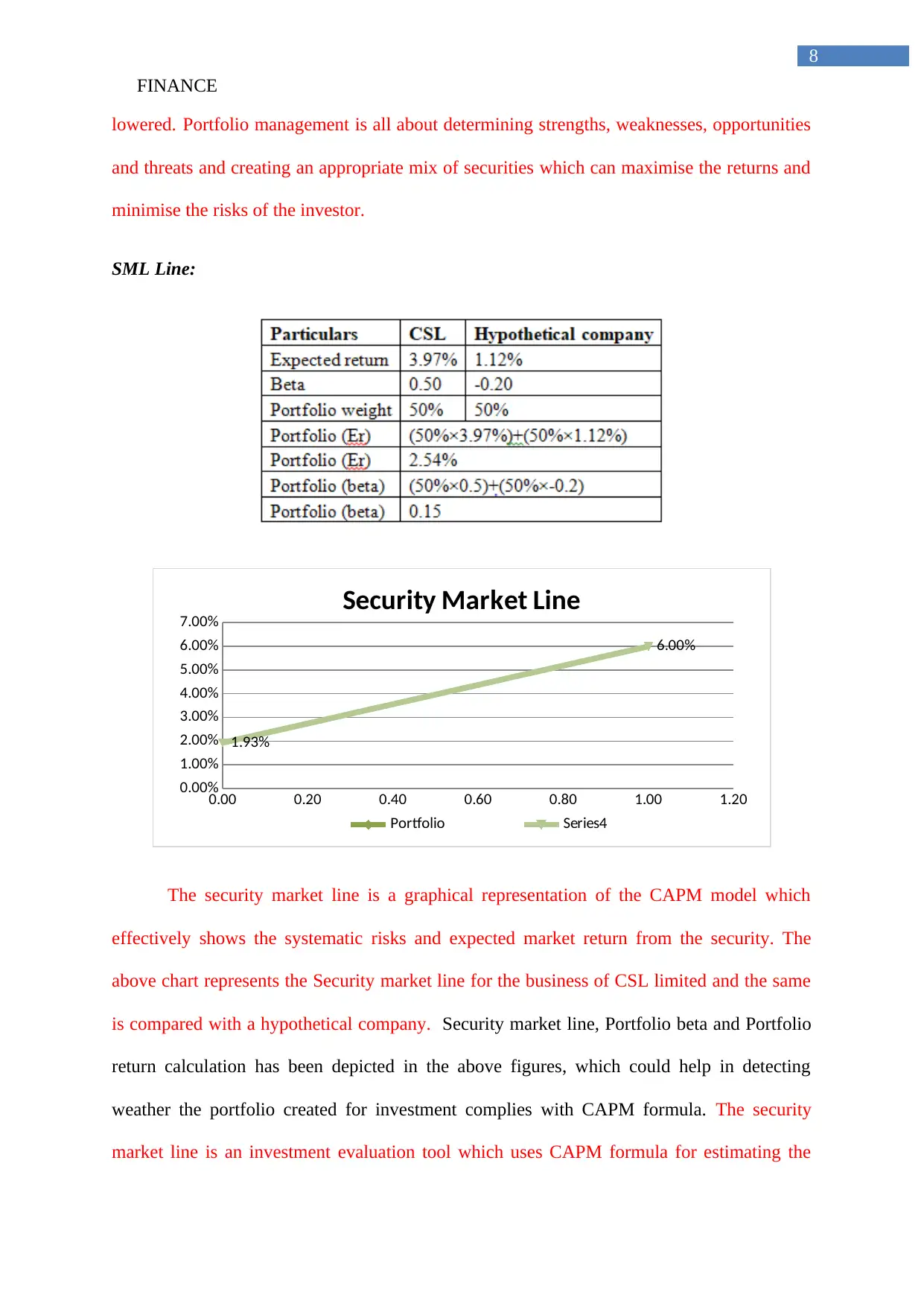
FINANCE
8
lowered. Portfolio management is all about determining strengths, weaknesses, opportunities
and threats and creating an appropriate mix of securities which can maximise the returns and
minimise the risks of the investor.
SML Line:
0.00 0.20 0.40 0.60 0.80 1.00 1.20
0.00%
1.00%
2.00%
3.00%
4.00%
5.00%
6.00%
7.00%
1.93%
6.00%
Security Market Line
Portfolio Series4
The security market line is a graphical representation of the CAPM model which
effectively shows the systematic risks and expected market return from the security. The
above chart represents the Security market line for the business of CSL limited and the same
is compared with a hypothetical company. Security market line, Portfolio beta and Portfolio
return calculation has been depicted in the above figures, which could help in detecting
weather the portfolio created for investment complies with CAPM formula. The security
market line is an investment evaluation tool which uses CAPM formula for estimating the
8
lowered. Portfolio management is all about determining strengths, weaknesses, opportunities
and threats and creating an appropriate mix of securities which can maximise the returns and
minimise the risks of the investor.
SML Line:
0.00 0.20 0.40 0.60 0.80 1.00 1.20
0.00%
1.00%
2.00%
3.00%
4.00%
5.00%
6.00%
7.00%
1.93%
6.00%
Security Market Line
Portfolio Series4
The security market line is a graphical representation of the CAPM model which
effectively shows the systematic risks and expected market return from the security. The
above chart represents the Security market line for the business of CSL limited and the same
is compared with a hypothetical company. Security market line, Portfolio beta and Portfolio
return calculation has been depicted in the above figures, which could help in detecting
weather the portfolio created for investment complies with CAPM formula. The security
market line is an investment evaluation tool which uses CAPM formula for estimating the
⊘ This is a preview!⊘
Do you want full access?
Subscribe today to unlock all pages.

Trusted by 1+ million students worldwide
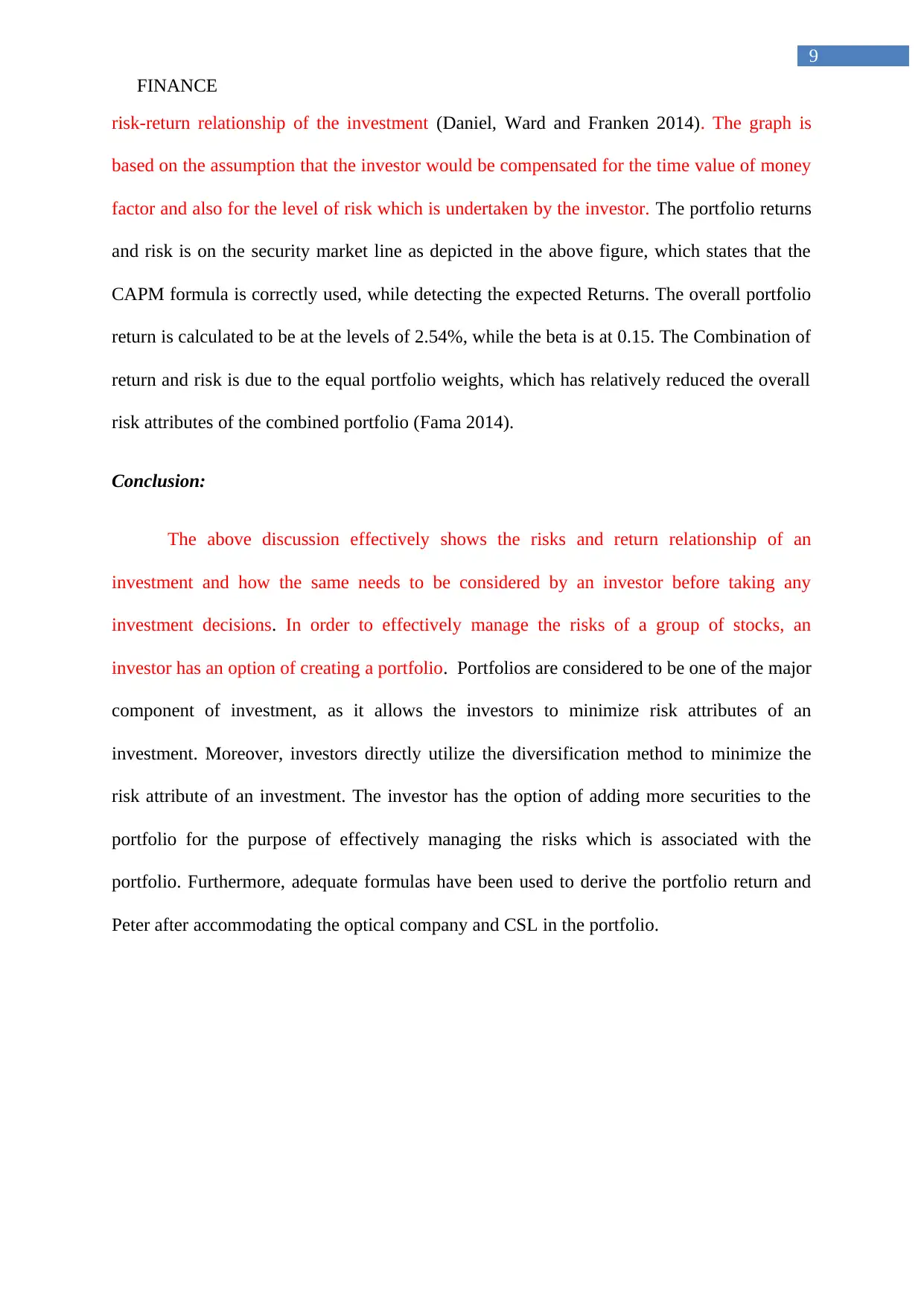
FINANCE
9
risk-return relationship of the investment (Daniel, Ward and Franken 2014). The graph is
based on the assumption that the investor would be compensated for the time value of money
factor and also for the level of risk which is undertaken by the investor. The portfolio returns
and risk is on the security market line as depicted in the above figure, which states that the
CAPM formula is correctly used, while detecting the expected Returns. The overall portfolio
return is calculated to be at the levels of 2.54%, while the beta is at 0.15. The Combination of
return and risk is due to the equal portfolio weights, which has relatively reduced the overall
risk attributes of the combined portfolio (Fama 2014).
Conclusion:
The above discussion effectively shows the risks and return relationship of an
investment and how the same needs to be considered by an investor before taking any
investment decisions. In order to effectively manage the risks of a group of stocks, an
investor has an option of creating a portfolio. Portfolios are considered to be one of the major
component of investment, as it allows the investors to minimize risk attributes of an
investment. Moreover, investors directly utilize the diversification method to minimize the
risk attribute of an investment. The investor has the option of adding more securities to the
portfolio for the purpose of effectively managing the risks which is associated with the
portfolio. Furthermore, adequate formulas have been used to derive the portfolio return and
Peter after accommodating the optical company and CSL in the portfolio.
9
risk-return relationship of the investment (Daniel, Ward and Franken 2014). The graph is
based on the assumption that the investor would be compensated for the time value of money
factor and also for the level of risk which is undertaken by the investor. The portfolio returns
and risk is on the security market line as depicted in the above figure, which states that the
CAPM formula is correctly used, while detecting the expected Returns. The overall portfolio
return is calculated to be at the levels of 2.54%, while the beta is at 0.15. The Combination of
return and risk is due to the equal portfolio weights, which has relatively reduced the overall
risk attributes of the combined portfolio (Fama 2014).
Conclusion:
The above discussion effectively shows the risks and return relationship of an
investment and how the same needs to be considered by an investor before taking any
investment decisions. In order to effectively manage the risks of a group of stocks, an
investor has an option of creating a portfolio. Portfolios are considered to be one of the major
component of investment, as it allows the investors to minimize risk attributes of an
investment. Moreover, investors directly utilize the diversification method to minimize the
risk attribute of an investment. The investor has the option of adding more securities to the
portfolio for the purpose of effectively managing the risks which is associated with the
portfolio. Furthermore, adequate formulas have been used to derive the portfolio return and
Peter after accommodating the optical company and CSL in the portfolio.
Paraphrase This Document
Need a fresh take? Get an instant paraphrase of this document with our AI Paraphraser
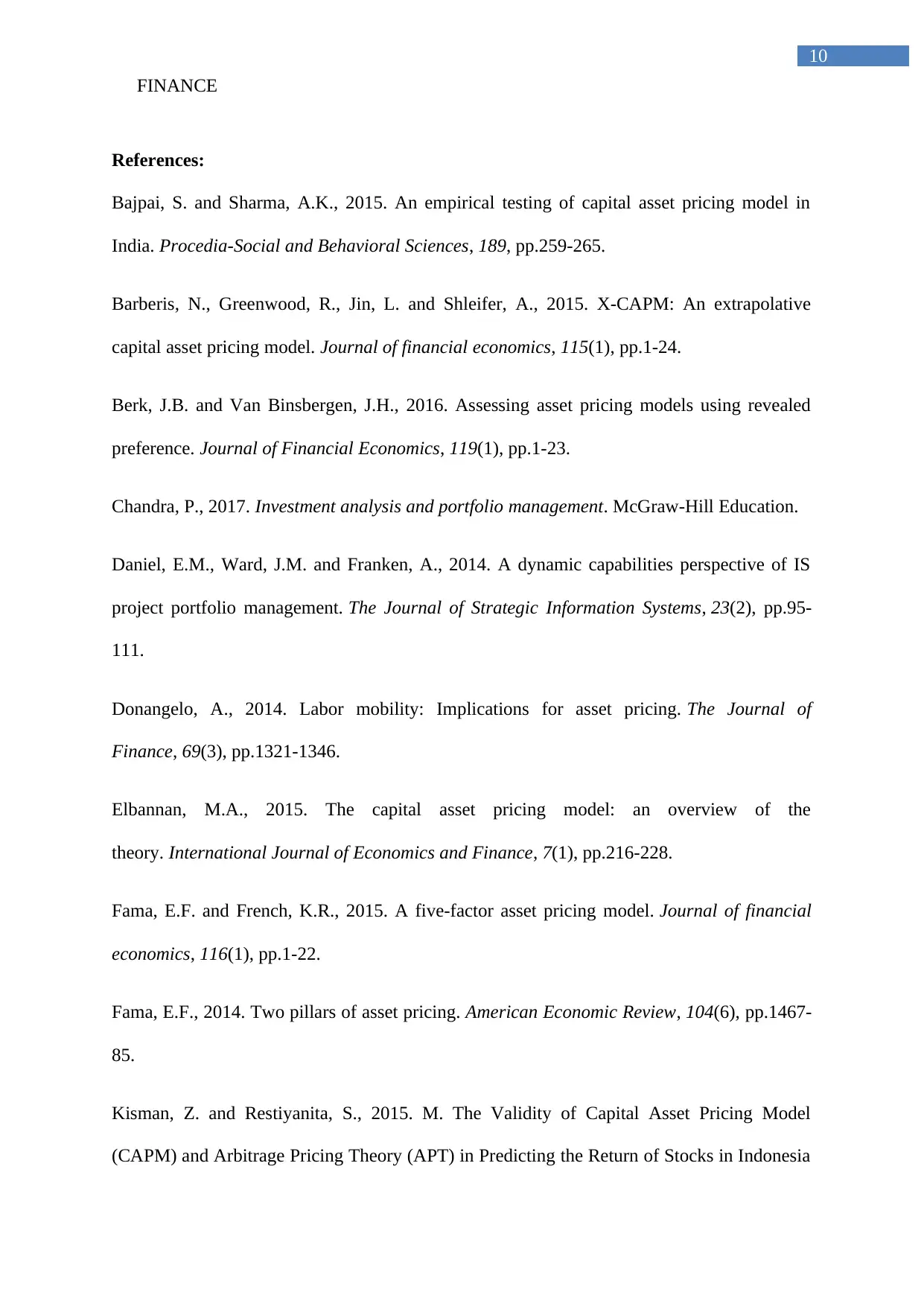
FINANCE
10
References:
Bajpai, S. and Sharma, A.K., 2015. An empirical testing of capital asset pricing model in
India. Procedia-Social and Behavioral Sciences, 189, pp.259-265.
Barberis, N., Greenwood, R., Jin, L. and Shleifer, A., 2015. X-CAPM: An extrapolative
capital asset pricing model. Journal of financial economics, 115(1), pp.1-24.
Berk, J.B. and Van Binsbergen, J.H., 2016. Assessing asset pricing models using revealed
preference. Journal of Financial Economics, 119(1), pp.1-23.
Chandra, P., 2017. Investment analysis and portfolio management. McGraw-Hill Education.
Daniel, E.M., Ward, J.M. and Franken, A., 2014. A dynamic capabilities perspective of IS
project portfolio management. The Journal of Strategic Information Systems, 23(2), pp.95-
111.
Donangelo, A., 2014. Labor mobility: Implications for asset pricing. The Journal of
Finance, 69(3), pp.1321-1346.
Elbannan, M.A., 2015. The capital asset pricing model: an overview of the
theory. International Journal of Economics and Finance, 7(1), pp.216-228.
Fama, E.F. and French, K.R., 2015. A five-factor asset pricing model. Journal of financial
economics, 116(1), pp.1-22.
Fama, E.F., 2014. Two pillars of asset pricing. American Economic Review, 104(6), pp.1467-
85.
Kisman, Z. and Restiyanita, S., 2015. M. The Validity of Capital Asset Pricing Model
(CAPM) and Arbitrage Pricing Theory (APT) in Predicting the Return of Stocks in Indonesia
10
References:
Bajpai, S. and Sharma, A.K., 2015. An empirical testing of capital asset pricing model in
India. Procedia-Social and Behavioral Sciences, 189, pp.259-265.
Barberis, N., Greenwood, R., Jin, L. and Shleifer, A., 2015. X-CAPM: An extrapolative
capital asset pricing model. Journal of financial economics, 115(1), pp.1-24.
Berk, J.B. and Van Binsbergen, J.H., 2016. Assessing asset pricing models using revealed
preference. Journal of Financial Economics, 119(1), pp.1-23.
Chandra, P., 2017. Investment analysis and portfolio management. McGraw-Hill Education.
Daniel, E.M., Ward, J.M. and Franken, A., 2014. A dynamic capabilities perspective of IS
project portfolio management. The Journal of Strategic Information Systems, 23(2), pp.95-
111.
Donangelo, A., 2014. Labor mobility: Implications for asset pricing. The Journal of
Finance, 69(3), pp.1321-1346.
Elbannan, M.A., 2015. The capital asset pricing model: an overview of the
theory. International Journal of Economics and Finance, 7(1), pp.216-228.
Fama, E.F. and French, K.R., 2015. A five-factor asset pricing model. Journal of financial
economics, 116(1), pp.1-22.
Fama, E.F., 2014. Two pillars of asset pricing. American Economic Review, 104(6), pp.1467-
85.
Kisman, Z. and Restiyanita, S., 2015. M. The Validity of Capital Asset Pricing Model
(CAPM) and Arbitrage Pricing Theory (APT) in Predicting the Return of Stocks in Indonesia
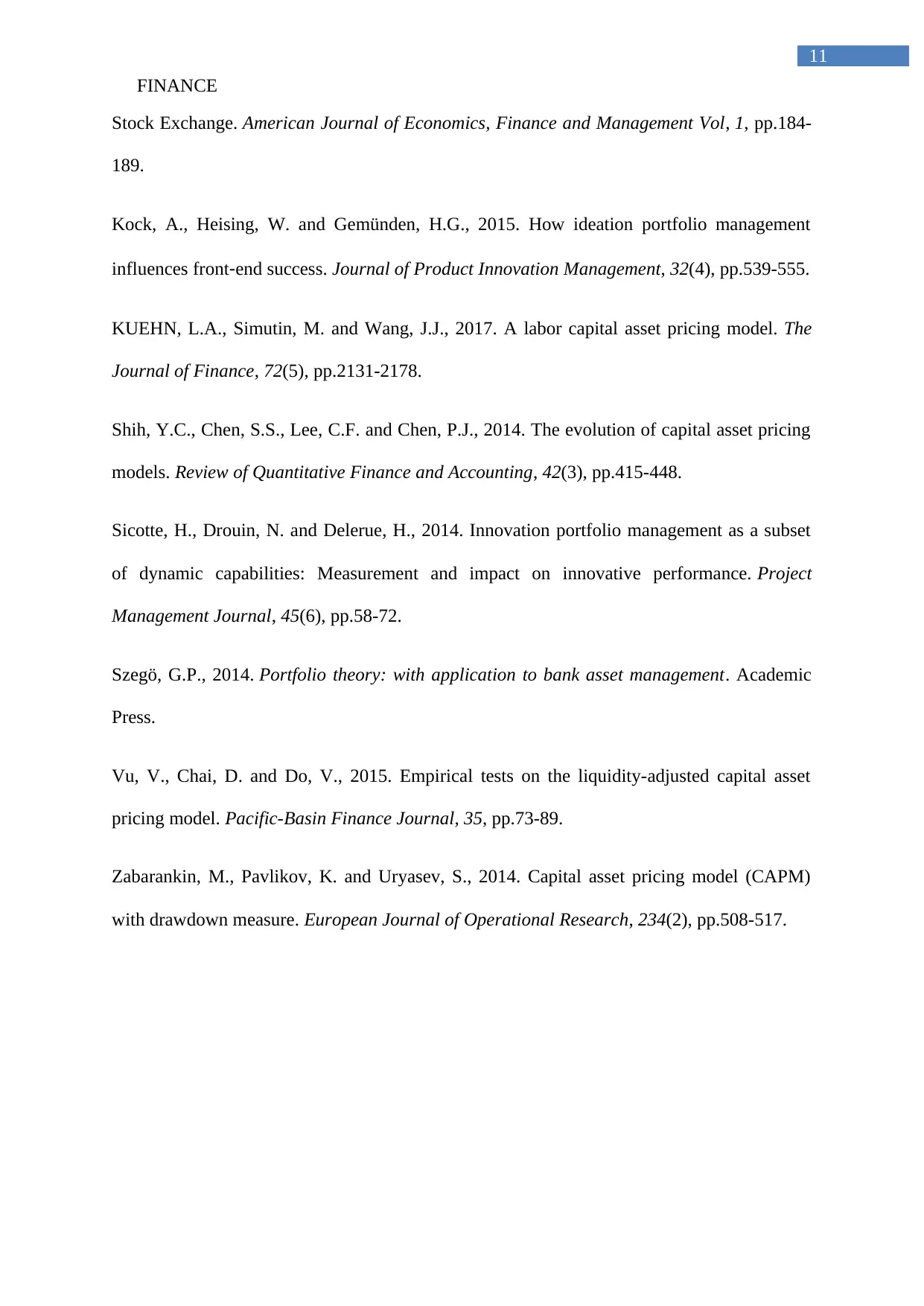
FINANCE
11
Stock Exchange. American Journal of Economics, Finance and Management Vol, 1, pp.184-
189.
Kock, A., Heising, W. and Gemünden, H.G., 2015. How ideation portfolio management
influences front‐end success. Journal of Product Innovation Management, 32(4), pp.539-555.
KUEHN, L.A., Simutin, M. and Wang, J.J., 2017. A labor capital asset pricing model. The
Journal of Finance, 72(5), pp.2131-2178.
Shih, Y.C., Chen, S.S., Lee, C.F. and Chen, P.J., 2014. The evolution of capital asset pricing
models. Review of Quantitative Finance and Accounting, 42(3), pp.415-448.
Sicotte, H., Drouin, N. and Delerue, H., 2014. Innovation portfolio management as a subset
of dynamic capabilities: Measurement and impact on innovative performance. Project
Management Journal, 45(6), pp.58-72.
Szegö, G.P., 2014. Portfolio theory: with application to bank asset management. Academic
Press.
Vu, V., Chai, D. and Do, V., 2015. Empirical tests on the liquidity-adjusted capital asset
pricing model. Pacific-Basin Finance Journal, 35, pp.73-89.
Zabarankin, M., Pavlikov, K. and Uryasev, S., 2014. Capital asset pricing model (CAPM)
with drawdown measure. European Journal of Operational Research, 234(2), pp.508-517.
11
Stock Exchange. American Journal of Economics, Finance and Management Vol, 1, pp.184-
189.
Kock, A., Heising, W. and Gemünden, H.G., 2015. How ideation portfolio management
influences front‐end success. Journal of Product Innovation Management, 32(4), pp.539-555.
KUEHN, L.A., Simutin, M. and Wang, J.J., 2017. A labor capital asset pricing model. The
Journal of Finance, 72(5), pp.2131-2178.
Shih, Y.C., Chen, S.S., Lee, C.F. and Chen, P.J., 2014. The evolution of capital asset pricing
models. Review of Quantitative Finance and Accounting, 42(3), pp.415-448.
Sicotte, H., Drouin, N. and Delerue, H., 2014. Innovation portfolio management as a subset
of dynamic capabilities: Measurement and impact on innovative performance. Project
Management Journal, 45(6), pp.58-72.
Szegö, G.P., 2014. Portfolio theory: with application to bank asset management. Academic
Press.
Vu, V., Chai, D. and Do, V., 2015. Empirical tests on the liquidity-adjusted capital asset
pricing model. Pacific-Basin Finance Journal, 35, pp.73-89.
Zabarankin, M., Pavlikov, K. and Uryasev, S., 2014. Capital asset pricing model (CAPM)
with drawdown measure. European Journal of Operational Research, 234(2), pp.508-517.
⊘ This is a preview!⊘
Do you want full access?
Subscribe today to unlock all pages.

Trusted by 1+ million students worldwide
1 out of 12
Related Documents
Your All-in-One AI-Powered Toolkit for Academic Success.
+13062052269
info@desklib.com
Available 24*7 on WhatsApp / Email
![[object Object]](/_next/static/media/star-bottom.7253800d.svg)
Unlock your academic potential
Copyright © 2020–2025 A2Z Services. All Rights Reserved. Developed and managed by ZUCOL.




